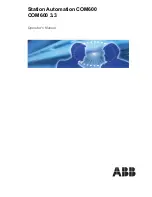
Chapter 6 Broadband
AMG1312-T Series User’s Guide
79
6.3.2 Configuring More Connections Advanced Setup
Use this screen to edit your AMG1312-T Series's advanced WAN settings. Click the
Advanced
Setup
arrow icon in the
More Connections Edit
screen. The screen appears as shown.
Figure 23
Network Setting > Broadband > More Connections: Edit: Advanced Setup
The following table describes the labels in this screen.
Table 15
Network Setting > Broadband > More Connections: Edit: Advanced Setup
LABEL
DESCRIPTION
RIP & Multicast Setup
RIP Direction
Select the
RIP Direction
from
None
,
Both
,
In Only
and
Out Only
.
RIP Version
This field is not configurable if you select
None
in the
RIP Direction
field.
Select the
RIP Version
from
RIP-1
,
RIP2-B
and
RIP2-M
.
Multicast
Internet Group Multicast Protocol (IGMP) is a network-layer protocol used to establish
membership in a multicast group. The AMG1312-T Series supports
IGMP-v1
,
IGMP-v2
and
IGMP-v3
. Select
None
to disable it.
ATM QoS
ATM QoS Type
Select
CBR
(Continuous Bit Rate) to specify fixed (always-on) bandwidth for voice or data
traffic. Select
UBR
(Unspecified Bit Rate) for applications that are non-time sensitive, such
as e-mail. Select
nrtVBR
(Variable Bit Rate-non Real Time) or
rtVBR
(Variable Bit Rate-
Real Time) for bursty traffic and bandwidth sharing with other applications.
Peak Cell Rate
Divide the DSL line rate (bps) by 424 (the size of an ATM cell) to find the Peak Cell Rate
(PCR). This is the maximum rate at which the sender can send cells. Type the PCR here.
Sustain Cell
Rate
The Sustain Cell Rate (SCR) sets the average cell rate (long-term) that can be transmitted.
Type the SCR, which must be less than the PCR. Note that system default is 0 cells/sec.
Maximum Burst
Size
Maximum Burst Size (MBS) refers to the maximum number of cells that can be sent at the
peak rate. Type the MBS, which is less than 65535.
MTU
Summary of Contents for AMG1312-T Series
Page 12: ...12 PART I User s Guide ...
Page 13: ...13 ...
Page 58: ...Chapter 4 Tutorials AMG1312 T Series User s Guide 58 Tutorial Advanced QoS Class Setup ...
Page 61: ...61 PART II Technical Reference ...
Page 62: ...62 ...
















































